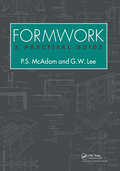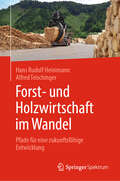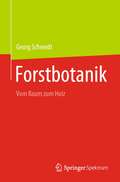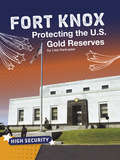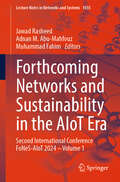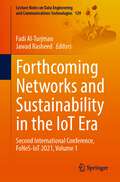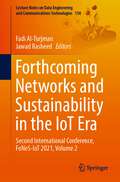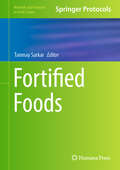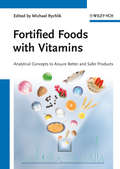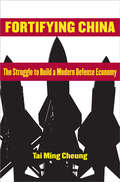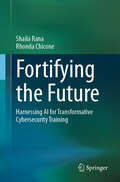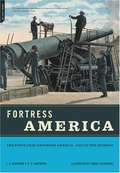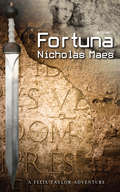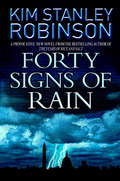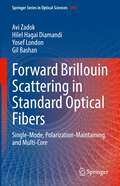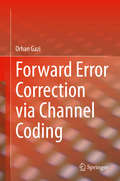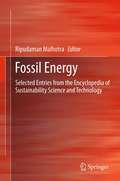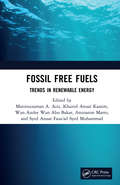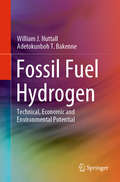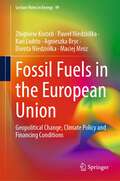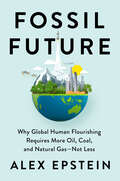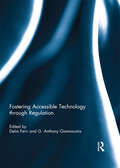- Table View
- List View
Formwork: A practical guide
by Geoffrey LeeTo optimise formwork costs and minimise the time for its construction, the contractor needs to understand the guiding principles of safe and efficient formwork construction. He must also have some insight into the relative merits of the various methods, and should appreciate the practical details of formwork construction.
Forst- und Holzwirtschaft im Wandel: Pfade für eine zukunftsfähige Entwicklung
by Hans Rudolf Heinimann Alfred TeischingerDas vorliegende Buch bietet eine Auslegeordnung, wie sich die Forst- und Holzwirtschaft Mitteleuropas orientieren kann, um die Nachhaltigkeits- und Klimawende mitzugestalten und zu einer Bioökonomie und Kreislaufwirtschaft beizutragen. Die Leitidee des Buches ist es, Optionen darzustellen und dies in der Absicht, die Vielfalt des Denkens und Handelns zu inspirieren. Vielfalt ist eine Voraussetzung, um mit unsicheren und unerwarteten Ereignissen, mit denen wir vermehrt konfrontiert sein werden, umgehen zu können. Das Buch analysiert, was die Leitbilder und Konzepte, welche den Nachhaltigkeits-, den Klima- sowie den sozialen Wandel prägen, für den Forst- und Holzsektor bedeuten. Es stellt danach die Hindernisse, welche die angestrebten Wenden behindern, und die „objektiven Realitäten“ dar, von denen eine Anpassung des Forst- und Holzsektors ausgehen muss. Die Pfade einer zukunftsfähigen Entwicklung beschreiben das wald- und holzspezifische Management des Kohlenstoffkreislaufes, die Weiterentwicklung des sozialen, institutionellen Arrangements, die Weiterentwicklung der Waldbausysteme sowie die Zukunft der stofflichen und energetischen Nutzung von Holz. Das Spektrum bisheriger Beiträge zum aktuellen Wandel sowie zu den Erwartungen und Anforderungen an Lösungen ist sehr breit und verkörpert die jeweils sehr spezifische Sichtweise einzelner Interessensgruppen. Dieses Buch ist ein Beitrag, Licht in das objektive Ödland, das in den letzten Jahren entstanden ist, zu werfen, und neben der Biodiversität in Wald und Natur auch die Diversität der Ideen zur erfolgreichen Bewältigung des Wandels zu stimulieren.
Forstbotanik: Vom Baum zum Holz
by Georg SchwedtDieses Buch schlägt für geschichtlich wie auch an der Natur interessierte Leserinnen und Leser den Bogen von der Historie, der Entstehung der Forstbotanik und der Entwicklung von Xylotheken bis zu den heutigen waldpädagogischen Ansätzen. Im ersten Abschnitt lernen Sie die wichtigsten Waldbäume anhand historischer Quellen vom Keimling, den Wurzeln, der Knospe bis zur Frucht und bis zu ihrem Holz kennen. Die detaillierten Beschreibungen der forstlich relevanten Laub- und Nadelbäume enthalten die ganze Naturgeschichte des jeweiligen Baumes und benennen auch deren Schädlinge. Zugleich erfahren Sie, wie sich die Bewirtschaftung von Bäumen im Forstbetrieb von der reinen Ökonomie zur Ökologie unter Berücksichtigung der Nachhaltigkeit entwickelt hat. Einen zweiten Schwerpunkt bilden die Beschreibungen und Anleitungen zu einem Baum-Herbarium nach den historischen Vorbildern der Xylotheken, die noch heute in Naturkundemuseen zu bewundern sind. Die eigene Anlage eines solchen Baum-Herbariums (in buchförmigen Holzkästen) erfolgt über eine Vegetationsperiode. Sie ermöglicht es Ihnen, sich jederzeit über die Botanik des jeweiligen Baumes – u.a. zu Knospen, Blüten, Blättern (auch Herbstlaub), Früchten, Rinde und Holz – unabhängig von der Jahreszeit durch eigene Anschauung zu informieren, wozu auch die Digitalmikroskopie zum Einsatz kommt.
Fort Knox: Protecting the U.S. Gold Reserves (High Security)
by Lisa HarkraderThe United States keeps its gold safe at Fort Knox. How is this done? There are fences, locks, guards, and more. Learn more about this high-security place!
Forthcoming Networks and Sustainability in the AIoT Era: Second International Conference FoNeS-AIoT 2024 - Volume 1 (Lecture Notes in Networks and Systems #1035)
by Jawad Rasheed Muhammad Fahim Adnan M. Abu-MahfouzThis book introduces a groundbreaking approach to enhancing IoT device security, providing a comprehensive overview of its applications and methodologies. Covering a wide array of topics, from crime prediction to cyberbullying detection, from facial recognition to analyzing email spam, it addresses diverse challenges in contemporary society. Aimed at researchers, practitioners, and policymakers, this book equips readers with practical tools to tackle real-world issues using advanced machine learning algorithms. Whether you're a data scientist, law enforcement officer, or urban planner, this book is a valuable resource for implementing predictive models and enhancing public safety measures. It is a comprehensive guide for implementing machine learning solutions across various domains, ensuring optimal performance and reliability. Whether you're delving into IoT security or exploring the potential of AI in urban landscapes, this book provides invaluable insights and tools to navigate the evolving landscape of technology and data science. The book provides a comprehensive overview of the challenges and solutions in contemporary cybersecurity. Through case studies and practical examples, readers gain a deeper understanding of the security concerns surrounding IoT devices and learn how to mitigate risks effectively. The book's interdisciplinary approach caters to a diverse audience, including academics, industry professionals, and government officials, who seek to address the growing cybersecurity threats in IoT environments. Key uses of this book include implementing robust security measures for IoT devices, conducting research on machine learning algorithms for attack detection, and developing policies to enhance cybersecurity in IoT ecosystems. By leveraging advanced machine learning techniques, readers can effectively detect and mitigate cyber threats, ensuring the integrity and reliability of IoT systems. Overall, this book is a valuable resource for anyone involved in designing, implementing, or regulating IoT devices and systems.
Forthcoming Networks and Sustainability in the AIoT Era: Second International Conference FoNeS-AIoT 2024 - Volume 2 (Lecture Notes in Networks and Systems #1036)
by Jawad Rasheed Muhammad Fahim Adnan M. Abu-MahfouzThis book introduces a groundbreaking approach to enhancing IoT device security, providing a comprehensive overview of its applications and methodologies. Covering a wide array of topics, from crime prediction to cyberbullying detection, from facial recognition to analyzing email spam, it addresses diverse challenges in contemporary society. Aimed at researchers, practitioners, and policymakers, this book equips readers with practical tools to tackle real-world issues using advanced machine learning algorithms. Whether you're a data scientist, law enforcement officer, or urban planner, this book is a valuable resource for implementing predictive models and enhancing public safety measures. It is a comprehensive guide for implementing machine learning solutions across various domains, ensuring optimal performance and reliability. Whether you're delving into IoT security or exploring the potential of AI in urban landscapes, this book provides invaluable insights and tools to navigate the evolving landscape of technology and data science. The book provides a comprehensive overview of the challenges and solutions in contemporary cybersecurity. Through case studies and practical examples, readers gain a deeper understanding of the security concerns surrounding IoT devices and learn how to mitigate risks effectively. The book's interdisciplinary approach caters to a diverse audience, including academics, industry professionals, and government officials, who seek to address the growing cybersecurity threats in IoT environments. Key uses of this book include implementing robust security measures for IoT devices, conducting research on machine learning algorithms for attack detection, and developing policies to enhance cybersecurity in IoT ecosystems. By leveraging advanced machine learning techniques, readers can effectively detect and mitigate cyber threats, ensuring the integrity and reliability of IoT systems. Overall, this book is a valuable resource for anyone involved in designing, implementing, or regulating IoT devices and systems.
Forthcoming Networks and Sustainability in the IoT Era: Second International Conference, FoNeS-IoT 2021, Volume 1 (Lecture Notes on Data Engineering and Communications Technologies #129)
by Fadi Al-Turjman Jawad RasheedThis book aims to provide a platform to the researchers and practitioners from both academia and industry to meet and share their experience and knowledge. Forthcoming Networks and Sustainability in the IoT Era (FoNeS-IoT), Volume 1 & 2, aims to bring together researchers and professionals to exchange ideas on the advancements in technology, application areas for advanced communication systems and development of new services, and facilitate a tremendous growth of new devices and smart things that need to be connected to the Internet through a variety of wireless technologies. Parallel to this, new capabilities such as pervasive sensing, multimedia sensing, machine learning, deep learning, unmanned aerial vehicles, cloud and edge computing, energy efficiency/harvesting, and computing power open the way to new domains, services, and business models beyond the traditional mobile Internet. The new areas in turn come with various requirements in terms of reliability, quality of service, and energy efficiency. These are only some examples of the challenges that are of interest to researchers in Forthcoming Networks and Sustainability in the IoT Era (FoNeS-IoT). It will explore the latest developments, innovations, and best practices within the IoT and the impact it has on industries including: manufacturing, transport, supply chain, communication, government, legal sectors, financial services, energy utilities, insurance, health care, retail, and many others. It provides opportunities for academicians and scientists along with professionals, policymakers, and practitioners from various fields in a global realm to present their research, contributions, and views, on one forum, and interact with members inside and outside their own particular disciplines. Papers describing applications of IoT in e-Health, Smart Systems & Management, Communication, and Education are also included, but the focus is mainly on how new and novel techniques advance the performance in application areas, rather than a presentation of yet another application of conventional tool. Papers on such applications describe a principled solution, emphasize its novelty, and present an in-depth evaluation of the techniques being exploited.
Forthcoming Networks and Sustainability in the IoT Era: Second International Conference, FoNeS-IoT 2021, Volume 2 (Lecture Notes on Data Engineering and Communications Technologies #130)
by Fadi Al-Turjman Jawad RasheedThis book aims to provide a platform to the researchers and practitioners from both academia and industry to meet and share their experience and knowledge. Forthcoming Networks and Sustainability in the IoT Era (FoNeS-IoT), Volume 1 & 2, aims to bring together researchers and professionals to exchange ideas on the advancements in technology, application areas for advanced communication systems and development of new services, and facilitate a tremendous growth of new devices and smart things that need to be connected to the Internet through a variety of wireless technologies. Parallel to this, new capabilities such as pervasive sensing, multimedia sensing, machine learning, deep learning, unmanned aerial vehicles, cloud and edge computing, energy efficiency/harvesting, and computing power open the way to new domains, services, and business models beyond the traditional mobile Internet. The new areas in turn come with various requirements in terms of reliability, quality of service, and energy efficiency. These are only some examples of the challenges that are of interest to researchers in Forthcoming Networks and Sustainability in the IoT Era (FoNeS-IoT). It will explore the latest developments, innovations, and best practices within the IoT and the impact it has on industries including: manufacturing, transport, supply chain, communication, government, legal sectors, financial services, energy utilities, insurance, health care, retail, and many others.It provides opportunities for academicians and scientists along with professionals, policymakers, and practitioners from various fields in a global realm to present their research, contributions, and views, on one forum, and interact with members inside and outside their own particular disciplines. Papers describing applications of IoT in e-Health, Smart Systems & Management, Communication, and Education are also included, but the focus is mainly on how new and novel techniques advance the performance in application areas, rather than a presentation of yet another application of conventional tool. Papers on such applications describe a principled solution, emphasize its novelty, and present an in-depth evaluation of the techniques being exploited.
Fortified Foods (Methods and Protocols in Food Science)
by Tanmay SarkarThis volume details the newest breakthroughs that are changing how researchers think about fortified foods. Chapters guide readers through nanoemulsions, liposome encapsulation, cutting-edge extrusion processes, and genetic tweaks. Subsequent chapters investigate liposome encapsulation to deliver vitamins, iron biofortification in meat products, and enzymatic hydrolysis to enhance protein in dairy alternatives. Written in the format of the Methods and Protocols in Food Science series, the chapters include an introduction to the respective topic, list necessary materials and reagents, detail well established and validated methods for readily reproducible laboratory protocols and contain notes on how to avoid or solve typical problems. Authoritative and cutting-edge, Fortified Foods aims to highlight the scientific basis that backs each strategy, while also tackling the real-world hurdles of large-scale implementation.
Fortified Foods with Vitamins: Analytical Concepts to Assure Better and Safer Products
by Michael RychlikUnique in its review of modern analytical approaches to vitamin fortification, this book emphasizes fast, sensitive, and accurate methods, along with assays enabling the detection of various isomers and multiple vitamins. The expert contributors describe the concepts as well as analytical and assay methods to study fortification, along with applications to create better and safer foods. Taking into considerations regulatory matters, they include data on sampling and extraction methods, and discuss the various pros and cons of each. As a result, readers are able to determine, which type of analytical method is best suited for added vitamins. A practical guide for food chemists and technologists, as well as analytical laboratories and biochemists.
Fortifying China: The Struggle to Build a Modern Defense Economy
by Tai Ming CheungFortifying China explores the titanic struggle to turn China into an aspiring world-class military technological power. The defense economy is leveraging the country's vibrant civilian economy and gaining access to foreign sources of technology and know-how. Drawing on extensive Chinese-language sources, Tai Ming Cheung explains that this transformation has two key dimensions. The defense economy is being reengineered to break down bureaucratic barriers and reduce the role of the state, fostering a more competitive and entrepreneurial culture to facilitate the rapid diffusion and absorption of technology and knowledge. At the same time, the civilian and defense economies are being integrated to form a dual-use technological and industrial base.In Cheung's view, the Chinese authorities believe this strategy will play a key role in supporting long-term defense modernization. For China's neighbors and the United States, understanding China's technological, industrial, and military capabilities is critical to the formulation of economic and security policies. Fortifying China provides crucial insight into the impact of China's dual-use technology strategy. Cheung's "systems of innovation" framework considers the structure, dynamics, and performance of the defense economy from a systems-level perspective.
Fortifying the Future: Harnessing AI for Transformative Cybersecurity Training
by Shaila Rana Rhonda ChiconeThis comprehensive handbook explores how artificial intelligence is transforming cybersecurity training, with a specific focus on practical implementation strategies for organizations. The book examines AI-driven approaches including personalized learning systems, gamification techniques, and immersive training environments using virtual and augmented reality. It provides detailed guidance on creating adaptive learning programs that respond to individual learner needs while addressing emerging cybersecurity threats. Key topics include AI-powered personalization of training content, development of realistic threat scenarios, integration of VR/AR technologies for hands-on practice, and implementation of gamification elements to boost engagement. The book offers concrete strategies for organizations to leverage AI in building more effective and engaging cybersecurity training programs that adapt to evolving security challenges. This handbook distinguishes itself from existing cybersecurity literature by focusing specifically on AI's application in training and skill development, rather than general cybersecurity operations. It serves both as a practical guide for professionals implementing AI-driven training programs and as a valuable resource for researchers and educators in cybersecurity, artificial intelligence, and organizational learning.
Fortress America: The Forts That Defended America, 1600 To The Present
by J. E. KaufmannFrom the earliest colonial settlements to Cold War bunkers, the North American continent has been home to thousands of forts and fortress structures. Fortress America surveys the broad sweep of fortifications throughout North America-from seacoast forts of the late eighteenth century to wooden inland forts built to defend against Native American, English,French, or Spanish attack; from Civil War-era coastal and inland waterways forts to the Great Plains' forts of the Old West; from World War II subterranean bunkers to Cold Warconcrete missile silos. The text of Fortress America is complemented with never-before-published photographs, and extraordinary drawings, cut-aways, and diagrams illustrating the design and structure of American forts.
Fortuna: A Felix Taylor Adventure
by Nicholas MaesFelix Taylor once stopped a devastating plague, but now he must save his world from humankind itself. It’s been a year since Felix Taylor travelled back to ancient Rome and saved his world from a lethal plague. Again his knowledge of Latin seems useless now that life in the 23rd century has returned to normal. But is it really?A stranger has discovered the time machine and used it to project back into the past. It becomes clear his purpose is to reverse Felix’s success, to bring back the plague and doom future generations to death. To make matters worse, this stranger is very close to Felix.With help from his friend Carolyn, Felix must return to the world of Julius Caesar, as well as a later era divided by religion, to stop the re-emergence of the plague. If he fails to do so, his world will turn to dust like ancient Rome.
Forty Signs of Rain (Capital Code #1)
by Kim Stanley RobinsonThe bestselling author of the classic Mars trilogy and The Years of Rice and Salt returns with a riveting new trilogy of cutting-edge science, international politics, and the real-life ramifications of global warming as they are played out in our nation's capital-and in the daily lives of those at the center of the action. Hauntingly realistic, here is a novel of the near future that is inspired by scientific facts already making headlines. <P><P> When the Arctic icepack was first measured in the 1950s, it averaged thirty feet thick in midwinter. By the end of the century it was down to fifteen. One August the ice broke. The next year the breakup started in July. The third year it began in May. <P><P>That was last year. <P><P>It's an increasingly steamy summer in the nation's capital as Senate environmental staffer Charlie Quibler cares for his young son and deals with the frustrating politics of global warming. Charlie must find a way to get a skeptical administration to act before it's too late-and his progeny find themselves living in Swamp World. But the political climate poses almost as great a challenge as the environmental crisis when it comes to putting the public good ahead of private gain. <P><P>While Charlie struggles to play politics, his wife, Anna, takes a more rational approach to the looming crisis in her work at the National Science Foundation. There a proposal has come in for a revolutionary process that could solve the problem of global warming-if it can be recognized in time. But when a race to control the budding technology begins, the stakes only get higher. <P><P>As these everyday heroes fight to align the awesome forces of nature with the extraordinary march of modern science, they are unaware that fate is about to put an unusual twist on their work - one that will place them at the heart of an unavoidable storm.
Forward Brillouin Scattering in Standard Optical Fibers: Single-Mode, Polarization-Maintaining, and Multi-Core (Springer Series in Optical Sciences #240)
by Avi Zadok Hilel Hagai Diamandi Yosef London Gil BashanThis book, the first dedicated to the topic, provides a comprehensive treatment of forward stimulated Brillouin scattering (SBS) in standard optical fibers. SBS interactions between guided light and sound waves have drawn much attention for over fifty years, and optical fibers provide an excellent playground for the study of Brillouin scattering as they support guided modes of both wave types and provide long interaction lengths. This book is dedicated to forward SBS processes that are driven by co-propagating optical fields. The physics of forward SBS is explained in detail, starting from the fundamentals of interactions between guided optical and acoustic waves, with emphasis given to the acoustic modes that are stimulated in the processes. The realization of forward SBS in standard single-mode, polarization-maintaining and multi-core fibers is then discussed in depth. Innovative potential applications in sensors, monitoring of coating layers, lasers, and radio-frequency oscillators are presented. This book introduces the subject to graduate students in optics and applied physics, and it will be of interest to scientists working in fiber-optics, nonlinear optics and opto-mechanics.Provides the first treatment of forward stimulated Brillouin scattering (SBS) in book form;Reflects the dramatic recent increase in interest in forward SBS processes , driven in part by the promise of new fiber sensing concepts;Delivers a solid and comprehensive grounding in the physics of forward SBS along with detailed experimental set-ups, measurement protocols, and applications.
Forward Error Correction via Channel Coding
by Orhan GaziThis book provides a comprehensive explanation of forward error correction, which is a vital part of communication systems. The book is written in such a way to make the subject easy and understandable for the reader. The book starts with a review of linear algebra to provide a basis for the text. The author then goes on to cover linear block codes, syndrome error correction, cyclic codes, Galois fields, BCH codes, Reed Solomon codes, and convolutional codes. Examples are provided throughout the text.
Fossil Energy
by Ripudaman MalhotraThe word sustainability shares its root with sustenance. In the context of modern society, sustenance is inextricably linked to the use of energy. Fossil Energy provides an authoritative reference on all aspects of this key resource, which currently represents nearly 85% of global energy consumption. Gathering 16 peer-reviewed entries from the Encyclopedia of Sustainability Science and Technology, the chapters provide comprehensive, yet concise coverage of fundamentals and current areas of research. Written by recognized authorities in the field, this volume represents an essential resource for scientists and engineers working on the development of energy resources, fossil or alternative, and reflects the essential role of energy supplies in supporting a sustainable future.
Fossil Free Fuels: Trends in Renewable Energy
by Maniruzzaman AzizMany approaches have been undertaken to mitigate global climate change, including the movement away from fossil fuels. Fossil Free Fuels: Trends in Renewable Energy examines several key topics, such as the utilization of biofuels as a sustainable renewable resource, recycling and untapped waste-to-energy products, and other carbon-neutral strategies in various industries, such as the transportation, construction, and manufacturing sectors. It provides recent updates on the latest technologies, modeling, design, and technical aspects, as well as several practical case studies. The current world energy scenario is examined and various solutions to larger environmental problems are outlined in terms of the shift to more alternative energy sources. Features: Minimizes technical jargon in a straightforward style for a wider audience Discusses sustainable options for different industries, such as the use of green materials in the construction sector, biofuels for transportation, and many more Includes numerous illustrations, tables, and figures to aid in understanding This book serves as a practical reference for engineers, researchers, environmental consultants working in renewable energy industries, and students.
Fossil Fuel (Energy Essentials)
by Nigel Saunders Steven ChapmanThis book tells you all about fossil fuel--coal, oil, and natural gas. It tells you amazing facts about how they were made and how we can use them in our everyday lives. It also explains the problems that fossil fuel can cause and how we need to find other ways of fueling our world--and soon.
Fossil Fuel Hydrogen: Technical, Economic and Environmental Potential
by William J. Nuttall Adetokunboh T. BakenneAs the case for Climate Change mitigation becomes ever more pressing, hydrogen has the potential to play a major role in a low-carbon energy future. Hydrogen can drive the vehicles of tomorrow and also heat homes and supply energy to businesses. Much recent discussion in energy policy circles has considered ways in which greatly expanded electrification can meet the demand for low-carbon mobility and heating. Such narratives centre on the widespread use of renewable energy sources with occasionally surplus renewable electricity being used to produce hydrogen, for example by electrolysis. While such developments have a beneficial role to play, this book focuses on an alternative paradigm. This book considers a more evolutionary path involving the continued extraction and use of fossil fuels, most notably natural gas, but in ways that greatly reduce greenhouse gas emissions. In this way much established industrial capacity and know how might be transitioned to help deliver the low carbon future that the world so desperately requires. Presenting up-to-date energy policy recommendations with a focus on hydrogen from fossil fuels, the book will be of considerable interest to policymakers and energy researchers in academia, industry and government labs, while also offering a valuable reference guide for business developers in low-carbon energy, and for oil and gas industry analysts.
Fossil Fuels in the European Union: Geopolitical Change, Climate Policy and Financing Conditions (Lecture Notes in Energy #99)
by Kari Liuhto Zbigniew Korzeb Paweł Niedziółka Agnieszka Bryc Dorota Niedziółka Maciej MrózThis book identifies scenarios for changes in transmission infrastructure, contracting, consumption patterns and fossil fuel financing policies, considering climate goals and the consequences of the conflict in Ukraine. The invasion of Ukraine by the Russian Federation has fundamentally changed the geopolitical situation, approaches to energy security issues, the EU’s energy (in)dependence and the implementation of previously outlined climate policies, including the planned gradual withdrawal from fossil fuels.This book presents the geopolitical architecture, energy mix, energy fuel supply structure, long-term energy policy and financing conditions of the oil and gas and sectors in the EU in the period preceding and following the Russian invasion of Ukraine. The authors consider the date of Russia’s attack on Ukraine as a symbolic caesura marking the beginning of the process of creating a new energy order in the EU. A novel part of the book is the attention it pays to the role of the credit and investment policy of the EU banking sector in relation to carbon-intensive sectors and to the significance of the financial system from the point of view of the effectiveness of international sanctions imposed on the Russian Federation, including, above all, sanctions related to the fossil fuel sector. The book is of interest to researchers and all those interested in learning about these subjects.
Fossil Future: Why Global Human Flourishing Requires More Oil, Coal, and Natural Gas--Not Less
by Alex EpsteinThe New York Times bestselling author of The Moral Case for Fossil Fuels draws on the latest data and new insights to challenge everything you thought you knew about the future of energyFor over a decade, philosopher and energy expert Alex Epstein has predicted that any negative impacts of fossil fuel use on our climate will be outweighed by the unique benefits of fossil fuels to human flourishing--including their unrivaled ability to provide low-cost, reliable energy to billions of people around the world, especially the world&’s poorest people. And contrary to what we hear from media &“experts&” about today&’s &“renewable revolution&” and &“climate emergency,&” reality has proven Epstein right: • Fact: Fossil fuels are still the dominant source of energy around the world, and growing fast—while much-hyped renewables are causing skyrocketing electricity prices and increased blackouts. • Fact: Fossil-fueled development has brought global poverty to an all-time low. • Fact: While fossil fuels have contributed to the 1 degree of warming in the last 170 years, climate-related deaths are at all-time lows thanks to fossil-fueled development. What does the future hold? In Fossil Future, Epstein, applying his distinctive &“human flourishing framework&” to the latest evidence, comes to the shocking conclusion that the benefits of fossil fuels will continue to far outweigh their side effects—including climate impacts—for generations to come. The path to global human flourishing, Epstein argues, is a combination of using more fossil fuels, getting better at &“climate mastery,&” and establishing &“energy freedom&” policies that allow nuclear and other truly promising alternatives to reach their full long-term potential. Today&’s pervasive claims of imminent climate catastrophe and imminent renewable energy dominance, Epstein shows, are based on what he calls the &“anti-impact framework&”—a set of faulty methods, false assumptions, and anti-human values that have caused the media&’s designated experts to make wildly wrong predictions about fossil fuels, climate, and renewables for the last fifty years. Deeply researched and wide-ranging, this book will cause you to rethink everything you thought you knew about the future of our energy use, our environment, and our climate.
Fostering Accessible Technology through Regulation
by Delia Ferri and G. Anthony GiannoumisTechnology has attracted an increasing level of attention within studies of disability and disability rights. Many researchers and advocates have maintained skepticism towards technology out of the fear that technology becomes another way to ‘fix’ impairments. These skeptical views, however, contrast with a more positive approach towards the role that technology can play in eliminating barriers to social participation. Legal scholarship has started to focus on accessibility and accessible technology and in conjunction with the recently adopted United Nations Convention on the Rights of Persons with Disabilities has put a great emphasis on accessibility, highlighting the role that accessible technology plays in the promotion and protection of the rights of people with disabilities. Against this background, this book gathers together different contributions that focus on enhancing the production, marketing and use of accessible technology. Building upon previous academic studies and in light of the UNCRPD, accessible technology is considered a tool to increase autonomy and participation. Overall, this book attempts to show, through a multifaceted and inter-disciplinary analysis, that different regulatory approaches might enhance accessible technology and its availability. This title was previously published as a special issue of the International Review of Law, Computers & Technology.
